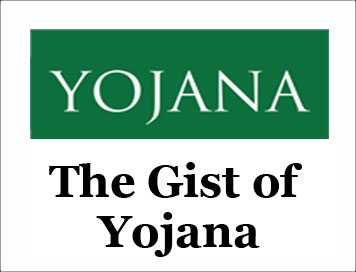(HOT) UPSC Current Affairs 2025 PDF
NEW! The Gist (NOV-2025) | E-BOOKS
(GIST OF YOJANA) A DECADE OF WASH
GIST OF YOJANA : A DECADE OF WASH
SEPTEMBER-2025
A DECADE OF WASH
Context:
The powerful revolution, one that has changed the face of rural India by restoring dignity, ease of living, health, and hope. This revolution is encapsulated in the twin flagship missions of Government of India: Swachh Bharat Mission-Gram (SBM-G) and JalJeevan Mission (JJM). Together, these missions have redefined the Water, Sanitation, and Hygiene (WASH) landscape by embedding technology in governance and placing rural communities, and Gram Panchayats at the heart of planning and execution. WASH initiatives have been pivotal in transforming the landscape of life standard, economy, social inclusivity and public health in India.
Historical Context of WASH in India
Ancient Roots:
-
Indus Valley Civilization (2500 BCE): Advanced drainage, household toilets.
-
Over time, especially during colonial rule, sanitation became a neglected public priority.
-
Caste-based stigmas reinforced habits like open defecation.
Post-Independence Efforts:
-
1951: First Five-Year Plan integrated health, water, sanitation.
-
1986 (CRSP): Central Rural Sanitation Programme launched for toilets and dignity of women.
-
Supply-driven, modest results due to poor community involvement.
-
1999 (TSC): Total Sanitation Campaign launched. Shifted focus from infrastructure to awareness, IEC, PRIs involvement.
-
2009 (NBA): Nirmal Bharat Abhiyan. Subsidies for BPL toilets, community led sanitation. States began framing sanitation policies.
-
2014: SBM launched to achieve comprehensive sanitation coverage.
Rural Water Supply Efforts
-
1954: National Water Supply Programme introduced.
-
1972-73: Accelerated Rural Water Supply Programme (ARWSP) to tackle scarcity and disease.
-
1986: National Drinking Water Mission (NDWM/Technology Mission).
-
1990s: Shift to decentralised, community managed reforms (Swajaldhara, 2002).
-
2009-10: NRDWP introduced, focused on sustainability.
-
2017: National Water Quality Sub-Mission (NWQSM) to address arsenic/fluoride contamination.
-
Despite progress, initiatives were fragmented, infrastructure-driven, with limited behaviour change.
2014 Onwards: Swachh Bharat Mission (SBM-G)
-
PM’s 2014 call to make India Open Defecation Free (ODF).
-
Largest sanitation drive in the world.
-
Over 10 crore toilets built to sanitation coverage rose from 39% (2014) to 100% (2019).
-
Phase II: Focus on Sampoorna Swachhata – sustaining ODF and managing solid/liquid waste.
Jal Jeevan Mission (JJM) – 2019
-
Announced on 15 August 2019 as Har Ghar Jal.
-
Vision: Every rural household has Functional Household Tap Connections (FHTCs).
-
Standard: 55 lpcd, BIS 10500 quality, reliable and affordable.
-
Subsumed NRDWP to shifted focus from fragmented supply to universal household coverage.
-
Community-Led Transformation
-
Gram Panchayats and communities became core drivers under SBM-G and JJM.
Village Action Plans (VAPs):
-
Cover drinking water, greywater, supply infra, quality monitoring.
-
Prepared by VWSCs/Pani Samitis with 50% women and SC/ST representation.
-
5.2 lakh VWSCs formed in 5.85 lakh villages with community ownership.
SBM-G Phase II:
-
Gram Panchayats led in sustaining ODF, retrofitting toilets, implementing SLWM.
-
4.61 lakh villages achieved ODF Plus Model status.
Technology and Innovation
-
Sanitation Technologies:
-
Twin Pit Toilets: affordable, safe, manure producing.
-
Plastic Waste Units: block-level shredding, recycling, SHG involvement.
Water Supply Innovations:
-
Insulated pipes in Ladakh to withstand extreme cold.
-
Solar-powered rural water schemes to renewable energy aligned.
-
Floating supply schemes in Gujarat for flood resilience.
Digital and IoT Solutions:
-
Flow meters, chlorine analysers, pressure sensors for real-time water monitoring.
-
2,183 water testing labs + mobile labs (e.g., Haryana).
-
WQMIS for citizens to view results and register grievances.
-
Governance and Grievance Redressal:
-
Helplines, call centres, mobile apps.
-
Social audits, Jan Sunwais, wall paintings for awareness.
-
Dashboards: SBM and JJM IMIS for realtime tracking.
Innovative Models:
- Toilet Clinics (Bihar): retrofitting, repair, janitors, SHG-led services with UNICEF support.
Behaviour Change and Citizen Engagement
Convergence with Other Schemes
-
MGNREGS: soak pits, recharge structures, toilets.
-
NHM: WASH in health centres, waterborne disease monitoring.
-
Samagra Shiksha Abhiyan: school sanitation and hygiene.
-
Aspirational District Programme: integrated WASH in backward districts.
-
Climate Change Adaptation Plans: resilient water and sanitation strategies.
Way Ahead
-
Sustain ODF Plus villages and build Swachh Sujal Gaons (ODFPlus +HarGharJal certified)
-
Ensure universal, equitable water access, with focus on marginalised groups.
-
Expand digital transformation: IoT, AI, GIS for tracking and planning.
-
Capacity Building at scale: engineers, VWSCs, barefoot technicians.
-
Strengthen Panchayats as local utilities and integrate WASH in GPDPs.
-
Foster inter-departmental collaboration for holistic services.
Conclusion:
The journey of SBM and JJM is not merely about numbers, it is about restoring dignity to rural women, preventing disease, creating livelihoods, and making governance participatory. It is about how a democracy, through its Panchayats and its people, empowered by technology, can truly transform the everyday lives of its citizens. The WASH revolution is evidence to what India can achieve when policy, people, and progress converge with purpose. As we enter the Amrit Kaal, the mission continues with renewed vigour, inclusive intent, and a shared commitment to leaving no one behind.
CLICK HERE TO DOWNLOAD FULL PDF
CLICK HERE TO DOWNLOAD UPSC E-BOOKS
Study Material for UPSC General Studies Pre Cum Mains
Get The Gist 1 Year Subscription Online
Click Here to Download More Free Sample Material
<<Go Back To Main Page
Courtesy: Yojana



